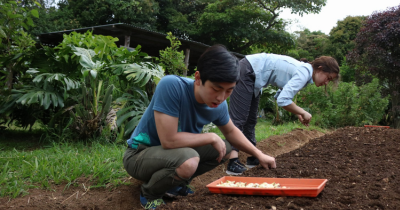Cultural Adjustment & Sustainability
Learn strategies to navigate cultural differences while practicing sustainable habits abroad, helping you make a positive impact in your new environment and community.
Understanding Your Impact
The way you engage with your host community shapes both your experience and the community itself. Cultural exchange should reach in both directions—toward people and structures. Your presence as a visitor can have lasting effects, both positive and negative.
Making a Sustainable Impact
Environmental Responsibility

Your choices matter. Consider these sustainable practices and reflect on your impact:
Transportation
- Use public transit or bike-sharing programs
- Walk when possible and safe
- Focus on deeply experiencing your host location rather than trying to visit every nearby country
- Choose trains over planes for regional travel
Daily Habits
- Carry a reusable water bottle (check local water safety first)
- Shop at local markets
- Learn and follow local waste sorting practices
- Be mindful of water and electricity usage
Supporting Local Communities

Your presence impacts the local community. Consider how you can contribute positively.
Economic Choices

- Support locally-owned businesses and restaurants
- Track exchange rates using OANDA Currency Converter to understand local costs
- Be mindful of how your spending might affect local prices
- Consider if your purchases are taking resources away from locals
Community Engagement

- Learn basic phrases in the local language, research basic history and local events
- Participate in community events when invited
- Seek to learn from local residents rather than just observe
- Ask permission before taking photos of people
- Respect local customs and traditions
Cultural Adjustment and Personal Growth
Reflecting on Identity
Take time to explore how different aspects of your identity might be perceived in your host country. Consider:
- Gender and Sexuality: Research local attitudes and norms around gender roles and LGBTQIA+ communities
- Race and Ethnicity: Understand the historical and current context of racial and ethnic relations
- Religion: Learn about religious practices and potential restrictions
- Socioeconomic Status: Consider how your financial position compares to local standards.
Explore Identity Abroad Resources
Cultural Adjustment Journey
It is commonly acknowledged that there are four stages of cultural adjustment, but this process is not always linear. You may find yourself moving back and forth between stages as you encounter new experiences, challenges, and personal growth. Understanding these phases can help you navigate the emotional and psychological shifts that come with living abroad.
1. The Honeymoon Stage
- Initial excitement about new surroundings
- Tourist-like involvement in the host culture
- High motivation to learn and engage
- Interest in cultural similarities and differences
2. Culture Shock Stage
- Focus shifts to differences between home and host cultures
- Small issues feel like major challenges
- Homesickness and frustration may emerge
- Might find yourself criticizing local practices
3. Gradual Adjustment Stage
- Increased understanding of local cultural logic and values
- Return of humor and perspective
- Recognition of preferred aspects in both cultures
- Deeper questioning of global assumptions
4. Adaptation Stage
- Feeling at home in your host country
- Balanced appreciation of cultural differences
- Ability to live and work to your full potential
- Integration into local community
Navigating Cultural Differences When Challenges Arise
It is natural to face challenges when adjusting to a new culture. When things get tough:
- Stop and Reflect - Ask yourself what your reaction reveals about your own cultural assumptions.
- Journal Your Experience - Writing can help you:
- Process your reactions
- Gain objectivity
- Understand cultural differences
- Track your adjustment progress
- Develop Practical Skills - Here are six strategies to build intercultural understanding, inspired by Slimbach’s framework:
- Cultivate curiosity and empathy—ask respectful questions and actively listen.
- Discover cultural conditioning—reflect on how your upbringing shapes your views.
- Recognize social variables—consider age, gender, or status in interactions.
- Identify situational contexts—notice what’s appropriate for the setting.
- Understand behavioral motivations—explore the values behind actions.
- Evaluate cultural generalizations—use patterns thoughtfully, not as rules.
Navigating cultural differences isn’t just about overcoming challenges; it’s about developing cultural intelligence, the ability to understand and adapt to diverse perspectives and practices. This skill is invaluable, both abroad and in your everyday life. It’s okay to feel overwhelmed or frustrated at times. These emotions are a natural part of the adjustment process and a sign that you’re growing. Sharing your experiences with others can help you process your journey and gain new insights. Remember, every challenge you face is an opportunity to build resilience, deepen connections, and thrive in your new cultural environment.
Cultural Exchange vs. Personal Boundaries
While cultural understanding is crucial, it doesn't mean accepting behavior that makes you unsafe or uncomfortable. If you experience harassment or feel unsafe:
- Trust your instincts
- Contact program staff
- Use available resources
- Document incidents
- Seek support
Resources and Tools
Sustainability Resources
Cultural Resources
US Government Resources
Go Beyond
- Johnson, M. (2009). Post-reciprocity: In defense of the "post" perspective. Frontiers: The Interdisciplinary Journal of Study Abroad, 18, 181-186.
- McLaren, D. (2006). Rethinking tourism and ecotravel. Bloomfield, CT: Kumarian Press.
- Potts, R. (2008). A slight rant about the rhetoric of "ethical travel." Retrieved from Vagabonding.
- Slimbach, R. (2005). The transcultural journey. Frontiers: The Interdisciplinary Journal of Study Abroad, 11, 205-230.
- Slimbach, R. (2012). Becoming world wise: A guide to global learning. Sterling, VA: Stylus Publishing.



